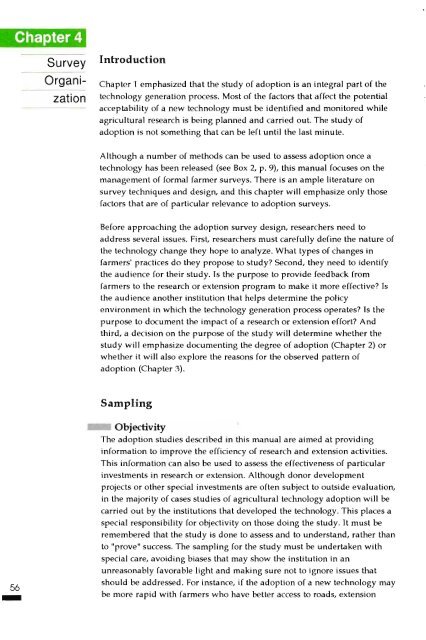The Adoption of Agricultural Technology - Food Security Group
The Adoption of Agricultural Technology - Food Security Group
The Adoption of Agricultural Technology - Food Security Group
Create successful ePaper yourself
Turn your PDF publications into a flip-book with our unique Google optimized e-Paper software.
Chapter4SurveyOrganizationIntroductionChapter 1 emphasized that the study <strong>of</strong> adoption is an integral part <strong>of</strong> thetechnology generation process. Most <strong>of</strong> the factors that affect the potentialacceptability <strong>of</strong> a new technology must be identified and monitored whileagricultural research is being planned and carried out. <strong>The</strong> study <strong>of</strong>adoption is not something that can be left until the last minute.Although a number <strong>of</strong> methods can be used to assess adoption once atechnology has been released (see Box 2, p. 9), this manual focuses on themanagement <strong>of</strong> formal farmer surveys. <strong>The</strong>re is an ample literature onsurvey techniques and design, and this chapter will emphasize only thosefactors that are <strong>of</strong> particular relevance to adoption surveys.Before approaching the adoption survey design, researchers need toaddress several issues. First, researchers must carefully define the nature <strong>of</strong>the technology change they hope to analyze. What types <strong>of</strong> changes infarmers' practices do they propose to study? Second, they need to identifythe audience for their study. Is the purpose to provide feedback fromfarmers to the research or extension program to make it more effective? Isthe audience another institution that helps determine the policyenvironment in which the technology generation process operates? Is thepurpose to document the impact <strong>of</strong> a research or extension effort? Andthird, a decision on the purpose <strong>of</strong> the study will determine whether thestudy will emphasize documenting the degree <strong>of</strong> adoption (Chapter 2) orwhether it will also explore the reasons for the observed pattern <strong>of</strong>adoption (Chapter ~).Sampling-56Objectivity<strong>The</strong> adoption studies described in this manual are aimed at proVidinginformation to improve the efficiency <strong>of</strong> research and extension activities.This information can also be used to assess the effectiveness <strong>of</strong> particularinvestments in research or extension. Although donor developmentprojects or other special investments are <strong>of</strong>ten subject to outside evaluation,in the majority <strong>of</strong> cases studies <strong>of</strong> agricultural technology adoption will becarried out by the institutions that developed the technology. This places aspecial responsibility for objectivity on those doing the study. It must beremembered that the study is done to assess and to understand, rather thanto "prove" success. <strong>The</strong> sampling for the study must be undertaken withspeCial care, aVOiding biases that may show the institution in anunreasonably favorable light and making sure not to ignore issues thatshould be addressed. For instance, if the adoption <strong>of</strong> a new technology maybe more rapid with farmers who have better access to roads, extension



